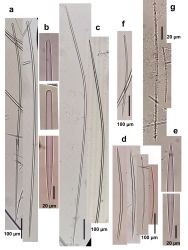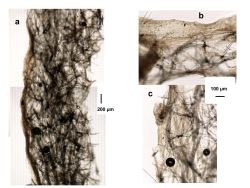orange
bushy
tough
Bahamas
Colombia
Higginsia coralloides
Description: Small bushes to erect thick branches, 2-3 cm to 10-12 cm high and 3-5 cm thick, with the surface formed by many evenly-spaced spiny, roundish or elongated processes from which spicules protrude, often trapping sediments; sometimes there are larger irregularities such as ridges and grooves. Oscules are not visible. Color scarlet to red orange. Consistency tough, elastic but difficult to tear. Skeleton as ascending, diverging and anastomosing spongin fibers, 30-90 µm thick, cored by tracts of 1-6 oxea spicules, and interconnedcted usually by single spicules, but sometimes tracts of 3-4 spicules, forming an overall ladder-like reticulation with irregular meshes, 50-200 µm wide. At the surface there is a 30-80 µm thick pinacoderm embedded by many acanthoxea and fewer thin oxea spicules. Spicules in three types: (1) oxea in two size categories, oxea I, the most common, slightly curved, hastate, with long sharp points, slightly telescopic, 310-600 µm long by 5.3-14 µm wide, with developmental stages as thin as 2.5 µm, and oxea II, very long and slender, slightly or strongly curved fusiform, 1200-1350 µm long by 8.3-10.5 µm wide; (2) curved styles with smooth, round or slightly narrow heads and sharp tips, in two size categories, styles I, rare, 275-490 µm long by 8 µm wide, and very long, styles II, slightly more abundant, 962-1200 µm long by 7.3-8.7 µm wide (but developmental stages as thin as 2.5 µm; (3) straight to slightly curved, thin acanthoxea (acanthomicroxea), 50-203 µm long and 1.8-2 µm wide, with sharp or blunt tips and many irregularly spaced thin and sharp spines.
Notes: This is a shallow but more often deep reef species, living exposed. It was previously known in the Caribbean as Higginsia strigilata (Lamarck, 1814), a name originally from Australia. From its bushy or ramose shape with hispid projections, it can be confused in the field with Ptilocaulis walpersii (with only styles) and with P. marquezii (oxea spicule only, smaller, no microxea).
Author Reference: Higgin, 1877
Link: World Porifera Database

![<i>Higginsia coralloides</i> <br />[Colombia, Santa Marta]](mini/00116/01254.jpg)

